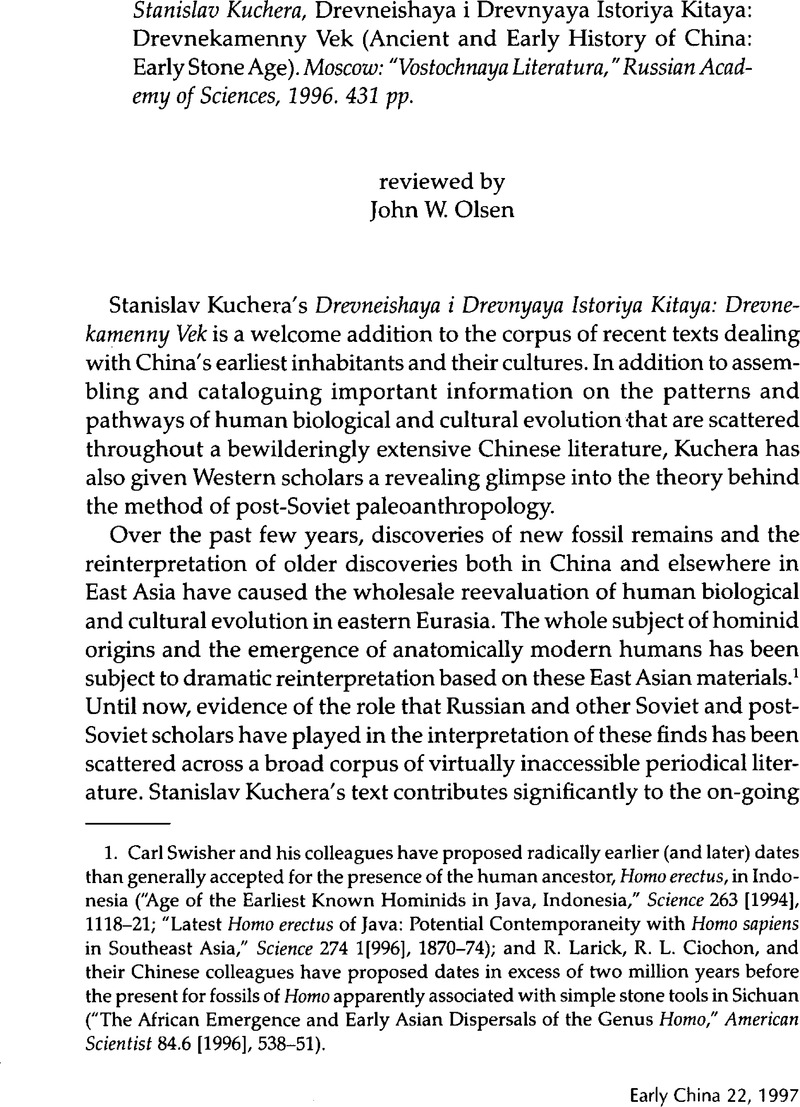Published online by Cambridge University Press: 26 March 2015

1. Carl Swisher and his colleagues have proposed radically earlier (and later) dates than generally accepted for the presence of the human ancestor, Homo erectus, in Indonesia (“Age of the Earliest Known Hominids in Java, Indonesia,” Science 263 [1994], 1118–21CrossRefGoogle Scholar; “Latest Homo erectus of Java: Potential Contemporaneity with Homo sapiens in Southeast Asia,’ Science 274 [1996], 1870–74)CrossRefGoogle Scholar; and R. Larick, R. L. Ciochon, and their Chinese colleagues have proposed dates in excess of two million years before the present for fossils of Homo apparently associated with simple stone tools in Sichuan (“The African Emergence and Early Asian Dispersals of the Genus Homo” American Scientist 84.6 [1996], 538–51)Google Scholar.
2. Kuchera takes great pains to explain the rationale for his use of the phrase “drevneishaya i drevnyaya istoriya” (ancient and early history) to describe that long period of human cultural development that most scholars would label simply “prehistory.” Complex, albeit elegant, explanations notwithstanding, I still believe this book should have been cast as, “Volume One, The Paleolithic,” in a series called “Preistoriya Kitaya,” “The Prehistory of China.”
3. Since Australopithecus is not currently recognized as a valid Chinese genus, the earliest human ancestors in China are all classified under Homo. Kuchera correctly regards the three molar teeth discovered at Jianshi 建始, Hubei, in 1970 as attributable to Homo (See Jian, Gao, “Australopithecine Teeth Associated with Gigantopithecus,” Vertebrata PalAsiatica 13.2 [1975], 81–88Google Scholar). Virtually all workers now agree that the only pre-sapiens species of Homo known to be present in China is H. erectus. In spite of the Chinese propensity for dividing H. erectus into many subspecies (e.g., H. e. pekinensis, H. e. yuanmouensis, H.e. lantianensis, etc.) most paleoanthropologists eschew this practice on the grounds that incomplete fossil remains alone do not preserve sufficient anatomical criteria to warrant subspecific classification. The term “neanderthal” is properly restricted in use to describe only some early Upper Pleistocene humans from Europe and western Asia. In China, contemporaries of the neanderthals are best classified as archaic members of Homo sapiens without further subspecific designation. Anatomically modern humans (e.g., those occurring after roughly 100,000 years ago) are all glossed simply as H. sapiens sapiens.
4. See Xinzhi, Wu and Poirier, Frank E., Human Evolution in China: A Metric Description of the Fossils and a Review of the Sites (New York: Oxford University Press, 1995)Google Scholar.
5. See Larick and Ciochon, “The African Emergence.”
6. See Kuchera's n. 34 on p. 312.
7. See n. 3 above.
8. See Swisher et al., “Age of the Earliest Known Hominids.”
9. See Larick and Ciochon, “The African Emergence.”
10. See Mochanov, Yu., Drevneishii Paleolit Diringa i Problema Vnetropicheskoi Prarodin' Chelovechestva (Novosibirsk: Nauka, 1992)Google Scholar; and Waters, et al., “Diring Yuriakh: A Lower Paleolithic Site in Central Siberia,” Science 275 (1997), 1281–84CrossRefGoogle ScholarPubMed.
11. For a brief, interesting discussion of ancient Chinese-Maya connections from an explicitly anthropological perspective, see Chang, K. C., The Archaeology of Ancient China, fourth ed. (New Haven:Yale University Press, 1986), 414–22Google Scholar.
12. See especially Kuchera's Maps 1 and 2 on p. 27 of his book.
13. See Lanpo, Jia and Weiwen, Huang, “On the Reconstruction of China's Palaeolithic Cultural Traditions,” in Palaeoanthropology and Palaeolithic Archaeology in the People's Republic of China, ed. Wu, R. K. and Olsen, J. W. (Orlando: Academic Press, 1985), 259–65Google Scholar.
14. Kuchera cites data provided by Zhang Senshui 張森水 to the effect that there are currently 100–150 known Paleolithic sites in China south of the Yangzi Jiang alone.
15. Kuchera quaintly refers to this as the “Neolithic Revolution.” It is also worth noting that the author labels the evolutionary bifurcation that signaled the beginning of divergent developmental pathways for human ancestors and their Great Ape cousins the “Pongid-Hominid Revolution.”
16. It took me the better part of two months just to initially read this text, although I'm sure those with native competence in Russian will fare much better.